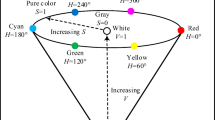Abstract
This paper proposes a novel visible watermarking scheme that is based on dynamic images and preserves context integrity. In our approach, the watermark is divided into many sub-watermarks, and then we utilize the visible watermark method to hide the sub-watermarks into difference images. When the dynamic image with the hidden watermark is done, the human visual system perceives that the watermark has integrity because of the persistence of human vision. Some verified information, including hash value, recovered data and remaining watermark, is used to maintain the image context and prevent tampering with the image. Moreover, our approach utilizes the histogram-based lossless data embedding scheme to completely recover the image context. Owing to the characteristics of lossless data hiding, the visible watermark can be completely removed, and the extracted data can be investigated. Accordingly, not only the image context is not changed but also no part of image quality is destroyed since the watermark is hidden and extracted.
















Similar content being viewed by others
Explore related subjects
Discover the latest articles and news from researchers in related subjects, suggested using machine learning.References
Zhang ZP, Wang SZ, Qian ZX, Feng G (2011) Reference sharing mechanism for watermark self-embedding. IEEE Trans Image Process 20(2):485–495
Fu Y, Shen R, Shen L (2004) Digital watermarking based on locally linear embedding. In: Proceedings of international conference on image processing (ICIP 2004), pp 24–27
Chang CC, Lin PY, Yeh JS (2009) Preserving robustness and removability for digital watermarks using subsampling and difference correlation. Inf Sci 179(13):2283–2293
Cox IJ, Miller ML, Bloom JA (2001) Digital watermarking: principles and practice. Morgan Kaufmann, San Mateo
Cox IJ, Miller ML, Bloom JA (2001) Watermarking applications and their properties. In: Proceedings of international conference on information technology: coding and computing (ITCC 2001), pp 6–10
Fridrich J, Goljan M, Du R (2002) Lossless data embedding—new paradigm in digital watermarking. EURASIP J Appl Signal Process 2002(2):185–196
Yen E, Tsai KS (2008) HDWT-Based grayscale watermark for copyright protection expert systems with. Applications 35(1–2):301–306
Huang BB, Tang SX (2006) A contrast-sensitive visible watermarking scheme. IEEE Multimed 13(2):60–66
Huang CH, Wu JL (2004) Attacking visible watermarking schemes. IEEE Trans Multimed 6(1):16–30
Jin C, Zhang XL (2009) Semi-fragile watermark based on adaptive quantization for image context authentication. In: Proceedings of international conference on e-business and information system security (EBIS 2009), pp 1–5
Kim KS, Lee MJ, Lee HY, Lee HK (2009) Reversible data hiding exploiting spatial correction between sub-sampled images. Pattern Recognit 42(11):3083–3096
Lee CF, Chen HL, Tso HK (2010) Embedding capacity raising in reversible data hiding based on prediction of difference expansion. J Syst Softw 83(10):1864–1872
Liu F, Wang YS (2003) An improved block dependent fragile image watermark. In: Proceedings of international conference on multimedia and expo (ICME 2003), pp 501–504
Liu TY, Tsai WH (2010) Generic lossless visible watermarking—a new approach. IEEE Trans Image Process 19(5):1224–1235
Luo H, Yu FX, Chen H, Huang ZL, Li H, Wang PH (2011) Reversible data hiding based on block median preservation. Inf Sci 181(2):308–328
Ni Z, Shi YQ, Ansari N, Su W (2006) Reversible data hiding. IEEE Trans Circuits Syst Video Technol 16(3):354–362
Thodi DM, Rodríguez JJ (2007) Expansion embedding techniques for reversible watermarking. IEEE Trans Image Process 16(3):721–730
Tian J (2003) Reversible data embedding using a difference expansion. IEEE Trans Circuits Syst Video Technol 13(8):890–896
Tsai HM, Chang LW (2007) A high security reversible visible watermarking scheme. In: Proceedings of international conference on multimedia and expo (ICME 2007), pp 2106–2109
Wang ZG, Wang J, Peng H (2009) A semi-fragile image watermarking resisting to JPEG compression. In: Proceedings of international conference on management of e-commerce and e-government (ICMECG 2009), pp 498–502
Yang Y, Sun XM, Yang HF, Li CT, Xiao R (2009) A contrast-sensitive reversible visible image watermarking technique. IEEE Trans Circuits Syst Video Technol 19(5):656–667
Acknowledgements
We would like to thank Mr. W.C. Tsai, who is a member of ICCL, for supporting all the experimental resultants in this article. This research was partially supported by the National Science Council of the Republic of China under the Grant NSC 100-2221-E-015-001-MY2- and NSC 99-2918-I-015-001-.
Author information
Authors and Affiliations
Corresponding author
Rights and permissions
About this article
Cite this article
Weng, CY., Zhang, Y.H., Lin, L.C. et al. Visible watermarking images in high quality of data hiding. J Supercomput 66, 1033–1048 (2013). https://doi.org/10.1007/s11227-013-0969-9
Published:
Issue Date:
DOI: https://doi.org/10.1007/s11227-013-0969-9




